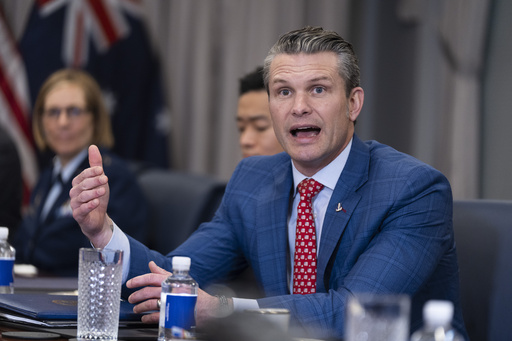
BRUSSELS — On Wednesday, U.S. Defense Secretary Pete Hegseth is set to make history as the first official from the new Trump administration to visit NATO headquarters. This visit comes at a critical juncture as NATO allies seek clarity on America’s strategy regarding the ongoing conflict in Ukraine.
As the third anniversary of Russia’s extensive invasion approaches, concerns loom large among U.S. allies, primarily regarding the implications of a Russian victory not just for Ukraine but for European security as well. If successful, experts worry that President Vladimir Putin may extend his ambitions beyond Ukraine’s borders, further destabilizing the region.
President Trump has expressed a desire to swiftly conclude the conflict, citing the financial burden it places on American taxpayers. Allies are anxious that any rushed agreement might be unfavorable to Ukraine and could potentially compromise their security interests.
During his visit, Hegseth will attend a meeting of the Ukraine Defense Contact Group at NATO’s Brussels location. This forum was initially established by former Defense Secretary Lloyd Austin in 2022 as a platform for gathering support and resources for Ukraine amidst the crisis.
In the past three years, a coalition of approximately 50 countries has pledged over $126 billion to assist Ukraine with military weapons and support. Notably, this week’s meeting will be hosted by the United Kingdom, marking a first. There’s no confirmation on who might lead any future meetings if they are scheduled.
Hegseth is not anticipated to announce any new military aid for Ukraine during his visit and will not hold individual talks with counterparts from Ukraine. Instead, he is expected to adopt a “listening mode” throughout the meetings, including Thursday’s NATO defense ministerial, according to a U.S. official.
When questioned about the potential deployment of U.S. troops to oversee weapons transfers to Ukraine, Hegseth clarified that such troops would not be sent into the country. Prior to leaving, the Pentagon indicated that Hegseth would articulate Trump’s commitment to achieving a diplomatic resolution to the ongoing war and emphasize the necessity for stronger European leadership in providing security support to Ukraine.
The anticipation from NATO’s 31 member nations regarding the new Trump administration’s approach to the alliance underscores the importance of this visit. Trump’s previous presidency left some European allies unsettled, especially after his remarks about withholding defense support from members not adhering to NATO’s military spending guidelines.
NATO operates on the principle that an attack on one member is considered an attack on all, triggering a collective response. This principle is especially critical for Ukraine as it seeks to solidify its security assurances.
An undisclosed senior NATO official remarked that a significant outcome of the meeting would be to establish constructive dialogue with the new U.S. administration while reaffirming the U.S. commitment to supporting Ukraine’s sustained effort in the conflict.
Mike Waltz, Trump’s national security adviser, implied over the weekend that European nations must take more responsibility for the ongoing conflict, asserting, “President Trump is going to end it. Security guarantees will largely rest with the Europeans.”
The discussion on Ukraine’s defense requirements and the need for increased military expenditure from European allies is set for Thursday. Since the onset of the conflict, European nations have significantly raised their military budgets, with 23 members reportedly reaching or surpassing the goal of 2% of GDP.
However, approximately one-third of NATO members still fall short of this target, which Trump is expected to address. Recently, he called for NATO allies to elevate their defense spending to 5% of GDP, a target yet to be achieved by any member state, including Poland, which is projected to approach this target this year.
While addressing reporters in Germany, Hegseth refrained from committing the U.S. to a 5% defense spending increase but expressed that it should surpass the former Biden administration’s levels and “should not go below 3 percent.” He noted that any final decision rests with Trump, emphasizing the necessity for responsible fiscal management given the constraints on taxpayer resources. Currently, the U.S. allocates roughly 3.3% of its GDP on defense.
NATO diplomats estimate a need for member countries to allocate between 3.5% and 3.7% of GDP to effectively implement the newly devised defense plans in case of aggression towards allied territories. Moving forward, the organization is expected to confirm new spending targets at their forthcoming summit scheduled for June 24-26 in The Hague.

